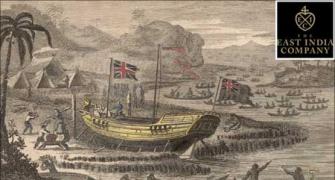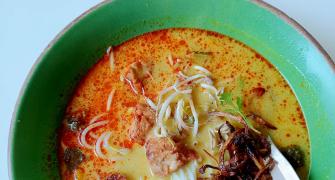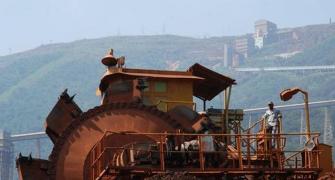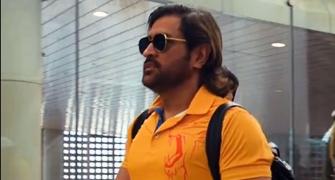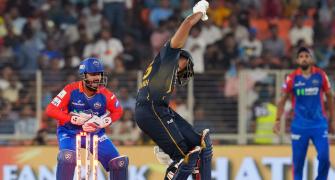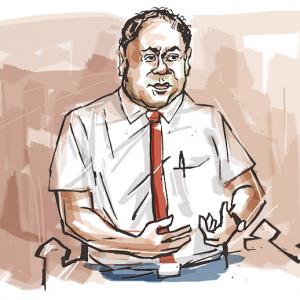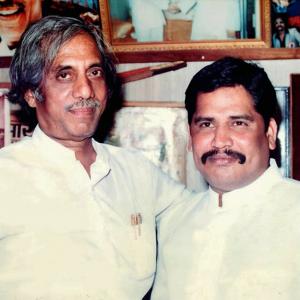Dr Gupta handled Shivade's blows with quite some equanimity...
So it was often only Shivade down in the mud pit, egging and enticing the doctor to join the fight, while Dr Gupta cautiously kept to the sidelines, barely stepping a toe into the mud.
Vaihayasi P Daniel reports from the Sheena Bora murder trial.
Illustration: Dominic Xavier/Rediff.com
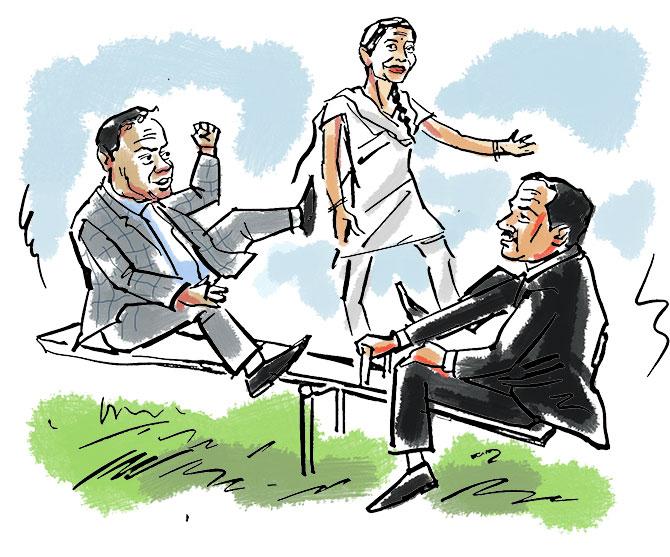
The sun had set and darkness had come to court by the time the intensely methodical, jumbo cross examination of Prosecution Witness 61 Dr Sudhir Kumar Gupta, by Peter Mukerjea's lawyer, Shrikant Shivade, ended at nearly 6.45 pm on Monday, January 20, 2020, in the Sheena Bora murder trial at Courtroom 51 at the Mumbai city civil and sessions court, Kala Ghoda, south Mumbai.
The six-hour 'cross' had been a fairly bumpy ride, with plenty of both expected and unexpected pockets of turbulence.
Further, there was much about Monday's proceedings that often muddied the waters and a simple picture did not emerge. Instead, a confusing multi-stranded narrative presented itself.
Rewind: Dr Gupta, professor and head of the department of forensic medicine at New Delhi's All India Institute of Medical Sciences, had been contacted by the Central Bureau of Investigation, in October 2015. with the request that he and his team submit a second opinion on a skeleton the police/CBI declared was Sheena Bora's, found near the village of Gagode Khurd, Raigad, rural Maharashtra in 2012, and exhumed in 2015.
That was not an unusual occurrence because AIIMS is often asked to weigh in on what is termed 'high-profile' cases.
Dr Gupta's 'testimony in chief' before the judge last Tuesday and Wednesday had not been particularly dramatic/electric or packed with any earth-shaking details, either new or old.
The team he had specially constituted at AIIMS to examine the remains concluded, in a report, that it was the skeleton of a woman of approximately 23 years and 158 cm +/- and the death -- in which 'asphyxia as a result of strangulation' cannot be ruled out.
This opinion -- based on 'elimination of associated causes of death' -- was pegged at having occurred three years before (they examined in 2015). These specifics approximately matched the specifics of Sheena's alleged homicide.
It was an extremely muscular, bicep-flaunting, Shivade, who started off his cross-examination of Dr Gupta, throwing out the punches at the forensic medicine expert as if he was undoubtedly the doctor and Dr Gupta at best a junior medical assistant.
This kind of role reversal, where the lawyer comes with enough professional tomes to scare the expert into wondering if he needs to redo his degree, is one of Shivade's prime battle stratagems.
They were not so unevenly matched, it would seem.
Because Dr Gupta, on the other hand, handled Shivade's blows with quite some equanimity, not getting hot under the collar. Nor going off track with long-winded answers or excessive irrelevant details. Or even throwing the punches back in this fairly engrossing bout of court-style mud-wrestling.
So it was often only Shivade down in the mud pit, egging and enticing the doctor to join the fight, while Dr Gupta cautiously kept to the sidelines, evasively, barely daintily stepping a toe into the mud.
In the highest moments of stress, he would twitch one hand or pause to take out a handkerchief and wipe his face (it was hot with the fans off and in proper Dilli style he was wearing a grey suit with thin blue checks).
But at the start of the 'cross' Shivade was on a charm offensive, several times referring to Dr Gupta as "Doctor Sahib" and commenting that he was a "very soft-spoken celebrity doctor."
That caused CBI Special Judge Jayendra Chandrasen Jagdale to muse, with a grin: "But you are a celebrity lawyer."
Bit by bit, Shivade's tone changed. At frequent intervals, he seemed to be, almost to the point of rudeness, strategically, testing Dr Gupta's medical knowledge, like how bones are measured or how many measurements are required or the formula used.
Or he would say: "Be quick. We have to finish today" or "My question is simple. Are you not able to understand?! And you are a gold medallist!"
Judge Jagdale would "Tsk, tsk" him or sternly reprimand with an "O Vakil Sahib", reminding Shivade that Dr Gupta was an expert and needed to be afforded politeness.
Confusion also often resulted when neither the judge nor the lawyer understood Dr Gupta's pronunciation of certain words.
Here were the main points of controversy or disagreement:
1. Shivade spent about 15 to 20 minutes trying to establish before the court a picture of an expert who had not actually done the legwork and was fuzzy about what his team had really done.
To that end the lawyer shot out questions, quizzing the doctor like: "Who dictated the report?" or "Who typed the final report?" and where and when was it typed, how long it took etc.
2. The lawyer wanted to know more about the books Dr Gupta had consulted and why he had not used the books he had.
Naming several top books, many (eight) of them on the lawyer's table in front of him, along with Gray's Anatomy in the courtroom, like British pathologist Bernard Knight's Forensic Pathology, he wondered why the doctor had not relied on what he deemed were the best books in the subject.
He also asked Dr Gupta to pinpoint at what exact juncture and date they had required the textbooks (more testing it would seem) and whether he actually had copies of the books or had got them from the library at AIIMS
3. Several questions followed asking Dr Gupta to name any other case the doctor had been involved in that was closest in its details to the Sheena Bora case ie identification of skeletal remains.
Dr Gupta could not recall any or even the cases he had been involved with before the Sheena Bora case that was about working with a skeleton. He did mention the Nitish Katara honour killing case and the Nithari serial child slayings.
4. Next was a scrutiny of the chain of custody procedures for articles under examination at AIIMS, an area where Shivade usually strikes gold.
Several queries later, the lawyer was able to establish that the articles/exhibits relating to a case (be they bones or samples or whatever) were not "kept under lock and key" although they were kept in Dr Gupta's department in rooms of the board members, that were "under lock and key", but the doctor could not remember if there was any AIIMS "protocol" for their handling.
Shivade, testily: "What is your reason for not remembering this fact?"
Dr Gupta: "I am not concerned with administration."
5. A critically relevant point that surfaced over and over again, at regular intervals, was the evidence of the workings or notes or minutes for the processes/meetings involved that lead the AIIMS "medical board" to make their conclusions.
Dr Gupta could offer no notes for any part of this process that had lasted nearly a month (from 13/10 to 9/11 in 2015). No written records for instructions or guidance given to the team when they visited the site in Raigad.
Or measurements of the bones examined or whether the bones had been weighed.
Or photographic results or notes of the facial reconstruction the doctors had attempted at AIIMS using plaster of Paris and putty.
He even agreed with the lawyer, at one point, that because of "absence of data, the findings arrived at cannot be objectively verified."
Everything had been verbal with no documentation to back up how the final report had been arrived at. The report itself, the lawyer accused, also apparently lacked these details -- enough basis for the conclusions.
Dr Gupta deemed them "unnecessary clerical work" that were not required.
Shivade pounced on that, much to Indrani Mukerjea's enthusiasm at the back. Indrani never misses a chance to do a bit of cheerleading of the defence lawyer via laughs, excitement, exaggerated nods of her head.
Shivade, almost apoplectic, for effect, asked: "Do you want to say measurement of bones by doctors is clerical work?" It later seemed it was more Dr Gupta's wrong choice of word and he meant "unmedical" and more anthropological.
It also emerged that AIIMS had relied largely on the results Mumbai's B Y L Nair hospital's forensic team had produced and that they had on most issues according to Dr Gupta "reiterated the same opinion with a little modifications by adding additional points."
6. Shivade, carefully worked his questions this way and that, to show that though Dr Gupta agreed that an "expert who is giving his opinion should be free from all bias" and his "end result" should depend on "scientific deliberations" there might have been some preconceived notions that could have been difficult to shake off. And therefore bias.
For instance, Dr Gupta said he had been vaguely aware -- "Just heard about some case" -- of the details of the case from the extensive media reportage at the time.
Secondly, the lawyer pointed out that the CBI's request to Dr Gupta mentioned that the skeleton was of Sheena Bora, aged 25, who had been 'killed by some drugs/sedatives and strangulation of her neck'.
Thirdly, Dr Gupta did not recall if he had spoken to the Pen-Raigad doctor who had conducted the first post mortem, Dr Sanjay Thakur, and though he concurred with Shivade that the 'doctor who conducted the first autopsy had the best opportunity to opine the cause of the death' he -- crucially -- did not remember what Dr Thakur had stated was the cause of death.
7. The lawyer quizzed the doctor repeatedly on the facts he remembered about the case. Be it whether he could recall if there had been any report they had perused on how the body had been found -- in the open -- or if a pH test of the soil had been conducted or how the time since death had been estimated.
Most questions drew a blank with Dr Gupta politely offering: "Exactly I do not remember."
8. While re-examining the remains, the AIIMS team had not conducted toxicology or DNA tests using their institution's facilities to see if the remains showed signs of poisoning or to see if all the remains belonged to one skeleton.
Instead, where required, they had asked the CBI to carry out the testing. Dr Gupta finally revealed, with an awkward smile, that they would require a court order to carry out their testing.
Shivade: "Did you tell them to get a court order?"
Dr Gupta, after a tiny uncomfortable silence said he had not because the CBI had their own labs.
Later, although Dr Gupta dodged the question the best he could -- even as Indrani giggled -- he finally admitted that till Monday he had not seen any toxicology report.
9. Shivade, then perforce, to create the courtroom effect he required, made Dr Gupta examine the skull that he had disdained from picking up at his 'chief' last week, for lack of gloves.
In an almost cinematic moment, Shivade, magically produced a white rubber glove from the jacket of his black coat and the lawyer seemed to challenge the doctor to have a go at it.
Caught off guard, the doctor mumbled something and then asked if the glove was from a sealed packet. Dr Gupta, not donning the glove, but using it like a pot holder or something, gingerly held the skull, looking at it uneasily, as if he had not held one in a rather long time.
10. Finally Shivade dwelled with great focus on a. Dr Gupta's assertion that reliance also on circumstantial evidence, given to them by an investigating agency, to determine the cause of death was fine and b. the declaration in the report, submitted by Dr Gupta and his team, that enumerated that there were basically 'four different causes of death' and through the process of elimination, because of absence of injury or fracture to the bones and blood on the bones, the causes got narrowed down, with strangulation one of the only options left.
The lawyer ran through several types of death where the skeleton would not sustain damage -- slitting of the throat, slitting an artery, burning, poisoning, acute subdural hematomas, a knife wound through the ribs (without damaging them) that could fatally wound a person if it slashed either the spleen, heart or liver, a less than 1m bullet that passed through the ribs.
While closing his cross, Shivade began to ask Dr Gupta about two incidents that allegedly affected his career record.
The first was about a paper that Dr Gupta had perhaps attempted to publish. And the second was about the book he had published, where Shivade said, portions had been "copied, even punctuations, commas and mistakes."
His former senior colleague at AIIMS Dr Tirath Das Dogra had accused Dr Gupta of -- according to Shivade -- "theft of a scientific paper" and had taken the matter to the Medical Council Of India. There was a move to have DR Gupta's name "struck off for the period of one year from the Indian Medical Register."
Dr Gupta emphatically denied the accusations, saying he would not lie under oath, still not losing his cool entirely, although his face looked dark and thunderous, He said several times in quiet anger: "You are demeaning me. I will not allow it."
He turned his back to Shivade, ignoring him, and began putting together his papers.
The judge reined Shivade in telling him it was "Jasta (too much)".
Dr Gupta pulled out a letter from his files from AIIMS that said he had "no major/minor penalty imposed" against him and no "vigilance case is pending or contemplated" and gave it to the judge.
Shivade's closing accusations were innumerable and strong: "You have no expertise whatsoever"... (You) did not conduct any examination. You are a handpicked expert of CBI... All findings regarding cause of death, age, sex etc are false and this is the reason as to why the record of measurements have not produced before court... Exclusion of other causes of death is highly unscientific and unheard in the history of forensic medicine anywhere in the world."
Dr Gupta did not reply, except at one point to say that his methods were scientific.
The lawyer then thanked the doctor and there was a sudden release of tension in the room. Dr Gupta grinned at Shivade and exited the witness stand, not too worse for the wear.
He said afterwards, without heat, that it had been a satisfactory cross examination and that he had been asked to depose as the senior-most member of the AIIMS team, to make impact in a critical case, but a lot of the detailed work had been done by his team members with his role being more supervisory or as a guide.
Dr Gupta was later spied smoking a cigarette outside the court, his jacket off and resting folded on his arm.
Vaihayasi Pande Daniel covers the Sheena Bora Murder Trial for Rediff.com. You can read her fascinating coverage here.



